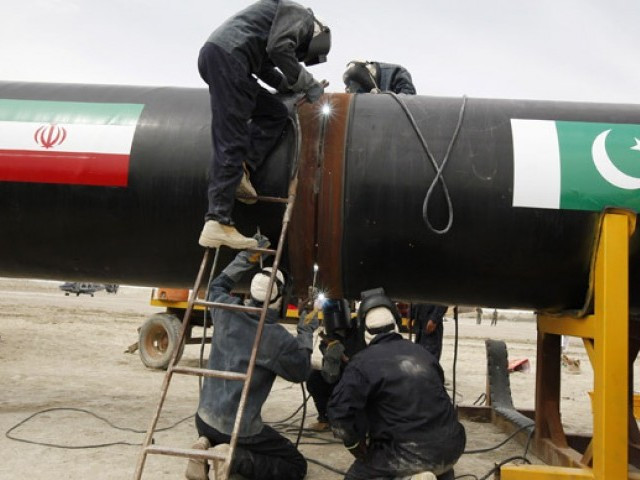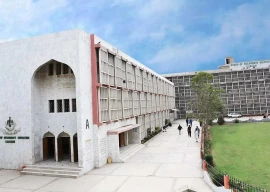
The Gwadar Nawabshah LNG Terminal and Pipeline Project is an alternative plan for laying the IP gas pipeline project which Islamabad committed to make to avoid penalties. However, the previous Pakistan Muslim League-Nawaz (PML-N) government had shelved the project.
After one of his visits from Saudi Arabia, the former premier Nawaz Sharif had called a meeting of Cabinet Committee on Energy (CCE) in which the Gwadar Nawabshah project was decided to be abandoned to the annoyance of Iran.
Russia wants to lay gas pipeline from Iran to India, but via Gwadar
Riyadh, which also cut diplomatic and economic ties with Qatar in 2017 due to the latter’s alleged ‘support for terrorism’, had also pressured Islamabad to reduce its relationship with Doha.
However, the PML-N government continued its LNG supply deal and diplomatic ties with Qatar. Then petroleum minister Shahid Khaqan Abbasi, who also served as the country’s PM after Sharif disqualification, had opposed shelving LNG Gwadar pipeline project but his opinion was not considered.
Sources told The Express Tribune that Iran had recently enquired from Pakistan about the measures that have been taken by it for removal of ‘force majeure’ conditions and revive implementation of IP gas pipeline project.
Iran also conveyed that in case Pakistan does not resolve the issues amicably, it would enforce its rights by means of all available contractual mechanism under the penalty clause of the gas sales purchase agreement (GSPA). This could include moving the international court against Pakistan to charge US$2.3 million per day penalty.
After Hassan Rouhani took over in 2013, Iran has unilaterally withdrew from the cooperation agreement with Pakistan resulting in a severe blow to the IP project as Iran had committed to provide US$ 500 million funding to build Pakistan segment of the gas pipeline, thus forcing Pakistan to issue a notice of ‘force majeure’ to Iran in March 2013.
The sources said the LNG Gwadar pipeline was a strategic project and foreign office had conveyed to Iran that Tehran was facing US sanctions which were hurdles in implanting IP gas pipeline project. It further asked Iran to view the situation in this context.
Pakistan was required to lay the Iran-Pakistan gas pipeline by December 2014, but the international sanctions on Iran for its alleged nuclear programme – a claim which Tehran forcefully rejects – prevented Islamabad from pressing ahead with the plan.
The Inter State Gas State Systems (ISGS) has a mandate to implement IP gas pipeline project.
When contacted the ISGS Managing Director Mobin Saulat said Gwadar Nawabshah LNG Terminal and pipeline project is a strategic one to boost activities at Gwadar Port and industry would be set up in free duty economic zone along with the China-Pakistan Economic Corridor (CPEC) which needs gas.
“Port Qasim Karachi has been congested and therefore different companies had to face multimillion dollars demurrages,” he said. A framework agreement was signed between Pakistan and China on April 20, 2015 for developing the Gwadar-Nawabshah LNG terminal and pipeline project.
Under the arrangement, China had committed to provide 85% of financing whereas Pakistan had to contribute 15% of equity. Exim Bank of China indicated to provide funds at London Interbank Offered Rate (Libor) plus 2%.
In a revised offer, China had withdrawn its offer of setting up an LNG terminal at Gwadar Port on the build-and-operate model and wanted to work as an engineering, procurement and construction (EPC) contractor for the project.
In response to the revision of offer by China, Pakistan will own and operate the terminal and award the EPC contract to the Chinese company working on the Gwadar LNG pipeline project under a government-to-government arrangement.
The ISGS had also proposed a plan of setting up two jetties at Gwadar Port with two floating LNG terminals at a cheaper cost for handling 1.2 billion cubic feet of imported gas per day (bcfd). According to an official, a meeting of the price negotiation committee had already been held during PML-N tenure.
During initial negotiations, the official said, it was discussed that tolling fee for the Gwadar LNG terminal would be 30 to 32 cents per million British thermal units (mmbtu) due to lower government profit.’
Earlier, the lowest bidder for the second LNG terminal, to be set up at Port Qasim, had quoted a fee of 41.70 cents per mmbtu. According to the official, one more floating ship will be installed at Gwadar Port with 10% additional cost. It will help store LNG in case of congestion at Karachi Port.
Then Petroleum Ministry had consistently pressed the government to add this project to the CPEC during the PML-N government, but to no avail. In support of the project, officials pointed out that several new industrial zones, which would be set up along the CPEC route, would require gas and that was why the government wanted to build the pipeline.
Under the plan, an LNG terminal will also be set up at Gwadar Port for handling and processing LNG imports, which would boost economic activity at the seashore. Officials insisted that the project was feasible even in the absence of Iranian gas flows as it would have an LNG terminal at the deep-sea port of Gwadar, where two LNG ships could be berthed at a time.
IP gas pipeline the most viable project, says former finance minister
The route had been the same for the Iran-Pakistan pipeline, which was finalised after a comprehensive front-end engineering design and feasibility study by an international engineering consultant, and it would be extremely difficult to win approval for the route once it is abandoned.
During the previous PML-N government, Gwadar-Nawabshah LNG terminal and pipeline project remained on paper, upsetting China that has been waiting to kick off work on the scheme.
The project file had been moving from one ministry to another. Then Ministry of Petroleum had been striving since the beginning to make it a part of the CPEC, but all its attempts failed. Instead, the Lahore Orange Line Metro Train project was included in CPEC.
After the CCE decided to drop the project, ISGS—the company mandated to do the project – was forced to stop all project related activities. The huge efforts stretching over the years for the implementation of the project were apprehended to go waste due to this decision of CCE.
The project activities would need to be restarted in case the new government decides to push the project forward with Iran despite the re-imposition of sanctions on Iran by US on August 7. Iran had already agreed for a price review to make it more economical as compared to other competing fuels like LNG and furnace oil.


















COMMENTS
Comments are moderated and generally will be posted if they are on-topic and not abusive.
For more information, please see our Comments FAQ